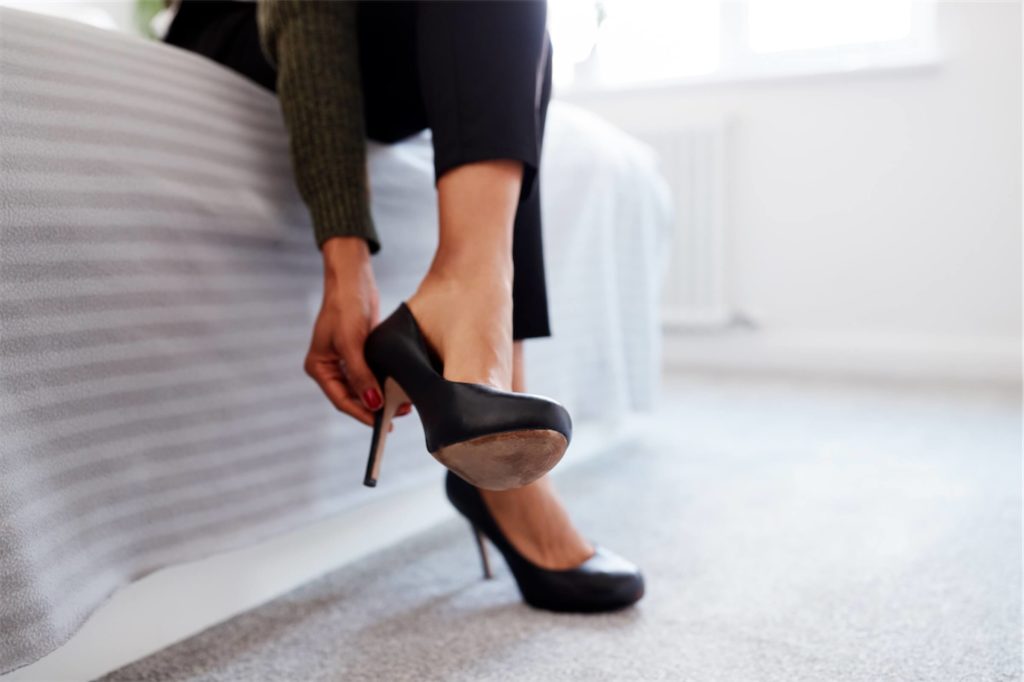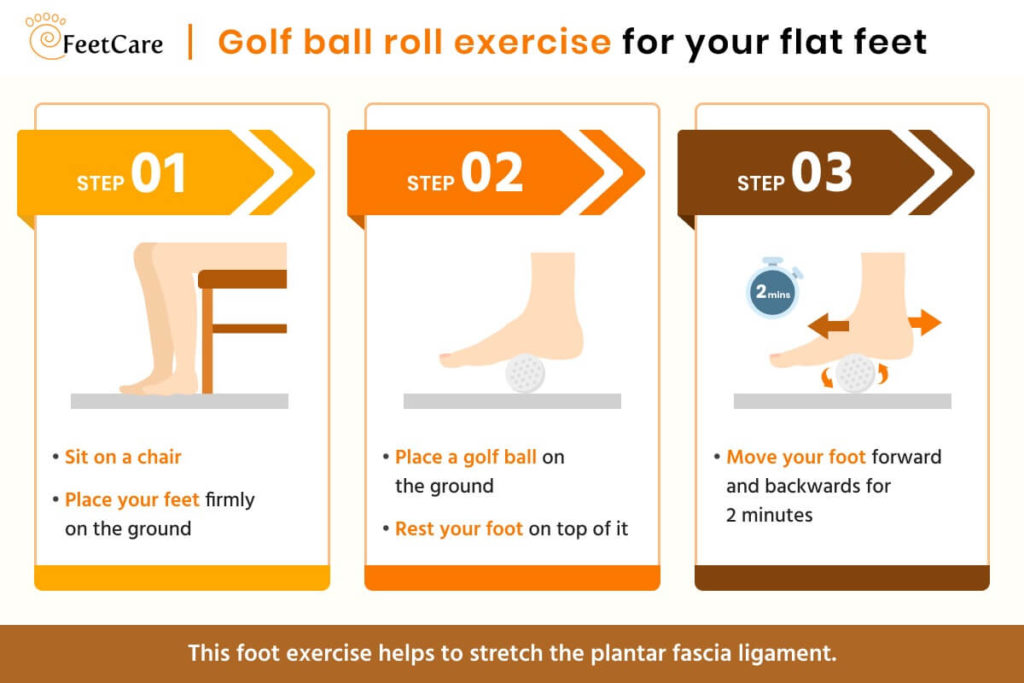Flat foot occurs when the arch on the inside of your foot is flattened, and the entire bottom of your foot (the sole) can touch the floor when you stand. It’s also known as a collapsed or fallen arch.
Flat foot is a relatively common condition. It’s usually painless but can sometimes contribute to ankle and knee problems, since having flat feet can alter the alignment of your legs.

What causes flat foot?
When you’re still a baby, flat feet are normal since your arches haven’t developed yet. Flat feet in children are relatively normal, and most children will grow out of their flat feet as their arches develop.
However, some of us don’t develop arches. This is considered a normal variation in the types of human feet, and not everyone with flat feet experiences problems.
Your arch can fall as a result of years of wear and tear. The posterior tibial tendon, which is the tendon that goes along the inside of your ankle and supports the arch, can weaken over time, which causes it to fall.
In more severe cases, it can be due to it being ruptured.
Common causes of flat feet include:
- Genetic factors: If your parents have flat feet, they may have passed it on to you
- Weak arches: Your arch is visible when you’re sitting or not putting pressure on your foot, but your foot flattens onto the ground when you stand
- Getting a foot or ankle injury
- Arthritis or rheumatoid arthritis
- Certain diseases that affect the nervous system or muscles, such as cerebral palsy, muscular dystrophy, or spina bifida
If you are overweight or diabetic, your risk of developing flat feet also increases.
Types of flat feet
Flexible flat feet
This is one of the most common types of flat feet. It usually begins in childhood or adolescence and continues into adulthood.
It’s called “flexible” as your arch returns when you’re not standing or when your feet are not bearing any weight.
It usually occurs in both feet and gets more severe as you get older. As the deformity worsens, the soft tissues (tendons and ligaments) of the arch may stretch or tear, and can become inflamed.
Rigid flat feet
Rigid flat feet tend to occur because of abnormal foot development, which may be a result of congenital defects (vertical talus) or abnormal connections between your foot bones (tarsal coalition). If rigid flat feet aren’t addressed, it can lead to the formation of painful calluses (thick patches on the skin), and it can be difficult to wear shoes and perform normal activities.
Vertical talus
In vertical talus, the lower bone in the ankle joint (talus) is wrongly positioned in comparison to the middle foot bones. This is a defect usually diagnosed at birth, perhaps even during ultrasound.
When this occurs, surgery is usually required to correct it. The foot is first stretched, and then surgery is performed between 6 months to 2 years of age to fix the dislocation and hold the bones in place.
After the surgery, you’ll need to wear a cast and brace, and sometimes tendons will also need to be lengthened.
Tarsal coalition
Tarsal coalition is usually present from birth, and tends to worsen with age.
It reduces the flexibility of your foot and causes the other parts of your foot to experience excessive amounts of pressure. Walking can be pretty painful for this condition.
What are the symptoms associated with a flat foot?
Walking is a repetitive motion — your heel touches the ground first, followed by the ball of the foot, and finally, the toes. When you have fallen arches, the arch of your foot touches the ground and then rolls inward too much when you shift your weight forward to take the next step.
During this entire heel-to-toe motion, the bones in the middle of your foot won’t be getting enough support because the tendons and ligaments that make up your arch are too loose.
Your foot ends up over-pronating as the arch drops, causing you to have disproportionate leverage in your foot. This causes excess strain on the muscles and joints of your foot, as well as your ankles.
Generally, most people won’t experience any symptoms associated with flat feet. However, some may experience pain in their feet, especially in the heel or arch.
This pain can get worse with activity, and you may see swelling along the inside of your ankle. You may also experience knee and hip aches, in addition to lower back pain.
Symptoms associated with flat foot
These symptoms are usually associated with flexible flat feet:
- Pain in the heel, arch, ankle, or along the outside of the foot
- Rolled-in ankle (over-pronation)
- Pain along the shin bone (shin splint)
- General aching or fatigue in the foot or leg
- Low back, hip, or knee pain
If your flat feet are causing you pain and you leave it untreated, it can progress into something worse like the conditions below.
| Condition | What is it? |
| Achilles tendonitis | Inflammation of the Achilles tendon, which runs down the back of your leg |
| Achilles tendon rupture | Breakage of the Achilles tendon |
| Arthritis | Damage caused to nerves outside of the brain and spinal cord |
| Bunions | Deformity of the big toe joint that results in swelling and pain |
| Hammertoe | Deformity that causes the toe to bend or curl downward instead of pointing forward. Most commonly affects the 2nd or 3rd toe, but can affect any toe |
| Plantar fasciitis | Inflammation of the plantar fascia—a tough ligament that connects your heel bone to your toes |
| Posterior tibial tendonitis | Inflammation or tearing of the posterior tibial tendon. This tendon connects one of the calf muscles to bones located in the inner foot |
| Shin splints | Inflammation of the muscles, tendons, and bone tissue around the tibia. Also known as medial tibial stress syndrome |
How do I care for my flat feet?
If your flat feet aren’t causing you any pain, there won’t be a need for treatment.

Good footwear and orthotic insoles for flat foot
If you have painful flat feet, then you’ll want well-fitted shoes that can provide you with adequate support. You can also get yourself fitted for custom insoles for flat feet or arch supports to help relieve pressure on your arch and reduce pain from your feet rolling too far inward.
Fitted insoles and orthotics or custom-designed arch supports may relieve pressure on the arch and reduce pain if the feet roll too far inward. Remember though that these products only relieve the symptoms, and won’t provide long-lasting benefits.
If you also suffer from posterior tibial tendonitis, you can try inserting a wedge into your footwear along the inside edge of your orthotic. This helps to relieve some of the load placed on the tendon tissue.
If you have inflammation on your ankle, you can also wear an ankle brace to help steady your feet until it reduces.
Physical therapy and exercises to help your flat feet
If you visit a podiatrist or physical therapist, they may recommend exercises to help you manage your flat feet symptoms.
These exercises recommended by the American Academy of Orthopaedic Surgeons (AAOS) help to improve strength and flexibility in your feet and ankles.

1. Heel cord stretching
If your Achilles tendon is tight, it can cause your foot to roll inward. The aim of this heel cord stretching exercise is to stretch your Achilles tendon and posterior calf muscles.
- Stand facing a wall and place one of your hands on the wall at eye level
- Place the leg that needs stretching approximately one step behind the other leg, and plant your heel firmly on the ground
- Bend the knee of your front leg until you feel a stretch in the back leg
- Hold for 30 seconds, and then rest for 30 seconds
- Repeat this step 9 more times
- Avoid arching your back and keep it straight. You’ll want to do this exercise twice a day.
2. The golf ball roll
For this exercise, you’ll need a chair and a golf ball. Rolling a golf ball under your feet can help to relieve discomfort in the arches, ease pain, and stretch the plantar fasciitis.
- Sit on the chair with your feet firmly on the ground
- Place the golf ball under your foot
- Roll the golf ball forward and back under the arch of your foot for 2 minutes to stretch the plantar fascia ligament
Are your flat feet giving you trouble? Contact us now, we’ll be happy to help you!




